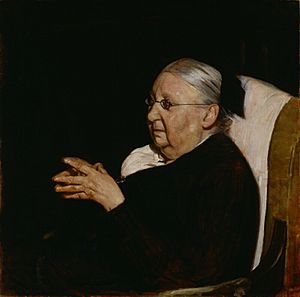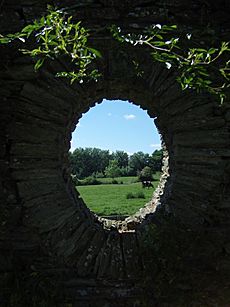Gertrude Jekyll facts for kids
Quick facts for kids
Gertrude Jekyll
|
|
|---|---|

Portrait of Jekyll by William Nicholson, painted October 1920; commissioned by Edwin Lutyens, donated to the Tate Gallery in 1921.
|
|
| Born | 29 November 1843 Mayfair, London, England
|
| Died | 8 December 1932 (aged 89) Munstead Wood, Busbridge, Surrey, England
|
| Occupation | Horticulturist, garden designer, writer and artist |
Gertrude Jekyll (pronounced JEE-kəl; born November 29, 1843 – died December 8, 1932) was a very talented British woman. She was known for many things! She was a gardener, a garden designer, a craftswoman, a photographer, a writer, and an artist.
Gertrude Jekyll designed over 400 gardens in the United Kingdom, Europe, and the United States. She also wrote more than 1,000 articles for popular magazines like Country Life. Many people who love gardening say she was a "premier influence" in garden design. This means she was one of the most important people in her field!
Contents
Early Life and Family
Gertrude Jekyll was born in London, England, on November 29, 1843. She was the fifth of seven children. Her father, Captain Edward Joseph Hill Jekyll, was an officer in the Grenadier Guards.
In 1848, when Gertrude was five years old, her family moved from London to a place called Bramley House in Surrey. She grew up there. Gertrude never married and did not have any children.
Her younger brother, Walter Jekyll, was a priest. He was a friend of the famous writer Robert Louis Stevenson. Stevenson even used the Jekyll family name for his well-known book, Strange Case of Dr Jekyll and Mr Hyde.
Designing Gardens with Art
Gertrude Jekyll was a key part of the Arts and Crafts movement. This was a time when people valued handmade items and traditional skills. She worked closely with a famous English architect named Edwin Lutyens. Together, they created many beautiful landscapes. Lutyens even designed Gertrude's home, Munstead Wood, in Surrey.
Jekyll is famous for her amazing garden designs. She used colors in a very special way, almost like a painter. Her "hardy flower borders" were especially well-known. She made her gardens look like paintings, with bright colors and sweeping shapes. Some people think her unique style might have been because her eyesight was getting worse. This made it harder for her to paint, so she put her artistic skills into gardening instead.
She was one of the first garden designers to think about how colors, textures, and even the feeling of a garden worked together. Her ideas about using color were inspired by the painter J. M. W. Turner and a style of art called Impressionism. She also used the idea of a color wheel to plan her designs.
Gertrude Jekyll started focusing on gardening while studying at the South Kensington School of Art. She became very interested in the art of planting. Later, she returned to her childhood village of Bramley, Surrey to design a garden called Millmead.
Sharing Her Knowledge
Gertrude Jekyll didn't just want to design gardens; she wanted to teach others about gardening too. She wrote many books and articles. Her book Colour Schemes for the Flower Garden is very famous. In it, she shared her ideas about using "warm" (like reds and oranges) and "cool" (like blues and purples) flower colors in gardens.
She also cared about how cut flowers looked inside a house. So, she designed her own glass flower vases!
Later in her life, Gertrude Jekyll collected many different plants. She gave them to institutions across Britain to help preserve them. By the time she passed away, she had designed over 400 gardens. She also wrote more than fifteen books, including Wood and Garden and her most famous, Colour in the Flower Garden.
Jekyll was also interested in old country crafts and furniture. She worried that these traditions were disappearing. Her book Old West Surrey (published in 1904) shows many parts of country life from the 1800s. It includes over 300 photographs that Gertrude Jekyll took herself.
Famous Gardens
Gertrude Jekyll started designing gardens in 1881. She designed or helped plan about 400 gardens in total. Many were direct requests from people, but she also worked with architects like Lutyens.
Sadly, most of her original gardens are now gone. However, a few have been brought back to life. These include her own garden at Munstead Wood, the beautiful gardens of Hestercombe House, and the gardens at Woolverstone House and the Manor House in Upton Grey.
Awards and Recognition
Gertrude Jekyll received several important awards for her work:
- In 1897, she was given the Victoria Medal of Honour by the Royal Horticultural Society.
- In 1929, she received the Veitch Memorial Medal from the same society.
- Also in 1929, she was awarded the George Robert White Medal of Honor from the Massachusetts Horticultural Society in the United States.
Burial Place
Gertrude Jekyll was buried in the churchyard of St John the Baptist church in Busbridge, Godalming. She rests next to her brother, Herbert Jekyll, and his wife, Agnes Jekyll. The memorial for the Jekyll family was designed by her friend, the architect Edwin Lutyens.
Legacy and Impact
In 1907, Gertrude Jekyll gave her collection of old household items and objects from "Old Surrey" to the Surrey Archaeological Society. Many of these items are still on display at Guildford Museum today. In 1911, the museum even built a special addition just to hold her collection!
On November 29, 2017, which would have been Gertrude Jekyll's 174th birthday, Google Doodle honored her with a special drawing on their homepage. This showed how important and remembered she is.
Images for kids
See also
 In Spanish: Gertrude Jekyll para niños
In Spanish: Gertrude Jekyll para niños








